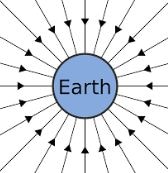Gravitational field strength
What is the Gravitational field?


Another point of view in the field concept. The gravitational field is a force field. The gravitational field exists around a particle. Whenever another particle enters the gravitational field, it will experience an attractive force. The field, therefore, plays an important role in our thinking about the forces between particles. According to this view, we first determine the gravitation field established by the given distribution of particles.
Secondly, we calculate the gravitational field exerted on another particle placed in its field. When a body is placed in the vicinity of the earth, it will experience an attractive force equal to the weight of the body m0 g. The direction of the gravitational force is towards the center of the earth. The gravitational field becomes weaker and weaker as we got farther and farther away from the earth.
The gravitational field is an example of a vector field, each point in this field having a vector associated with it. There are also scalar fields, such as temperature fields in a heat-conducting solid. The gravitational field arising from a fixed distribution of matter is also an example of a static field because the value of the field at a given point does not change with time.
Read Also: Gravitational Law
What is Gravitational field strength?
The gravitational field strength at a point is defined as ” Gravitational force per unit mass at that point. “At any place, its value is equal to the value of g at that point. Near the surface of the earth, the gravitational field strength value is 10 N kg-1.
Gravitational field Strength Formula
Its formula is given as:
g = F/mo
Where m0 is the test mass. By moving the test mass to various positions, we can make a map showing the gravitational field at any point in space. We can then find the force on a particle at any point in that field by multiplying the mass m of the particle by the value of the gravitational field g at that point:
F = mg
Related Post
Recent Posts
Is energy quantized in classical physics?
No, according to classical wave theory the emission of electromagnetic radiations from the surface is…
Types of laser
Basically, there are four types of laser which includes: Gas Lasers Solid State lasers Liquid…
Ultrasound frequency range
What is ultrasonics? The study and application of mechanical vibrations with frequencies beyond the limits…
Electromagnetic Energy: What are some examples of it?
Electromagnetic energy definition Electromagnetic energy is the amount of energy stored in a region of…
Fundamental units and Derived Units with Examples
The Main Difference between fundamental Units and Base units is that Units that Express base…
Newton’s First law of Motion Examples in Our Daily Life
Newton's first law of motion states that " A body continues its state of rest…